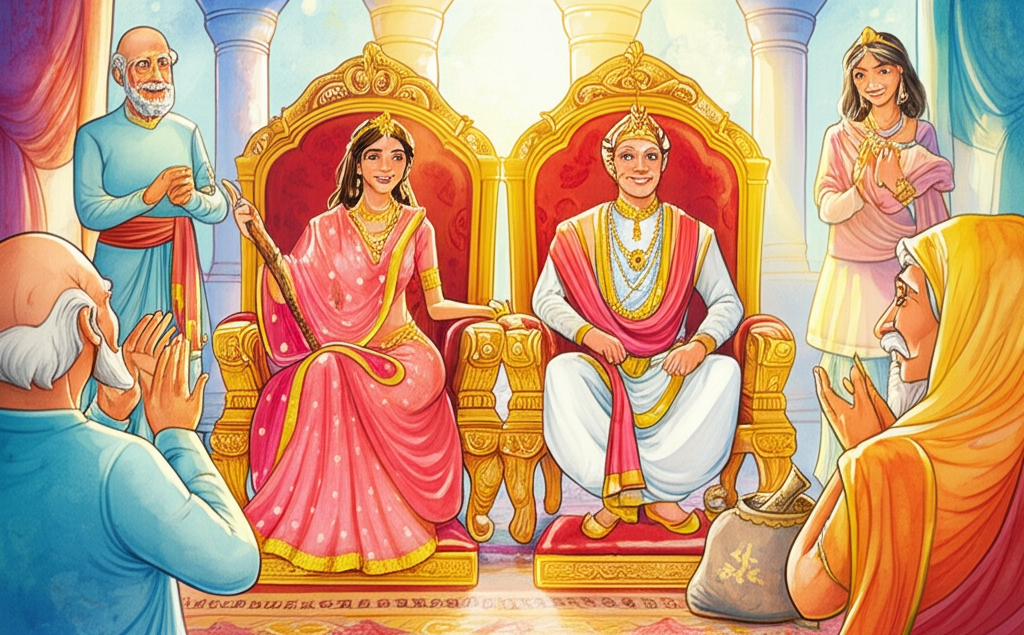Once upon a time, in a faraway land, lived a king called a Raja. He had a son who loved to go hunting every day. One day, the queen, who was his mother, said, “You can hunt anywhere on these three sides, but you must never go to the fourth side.” She said this because she knew that if he went to the fourth side, he would hear about the beautiful Princess Labam, and then he would want to leave his parents and go find her.
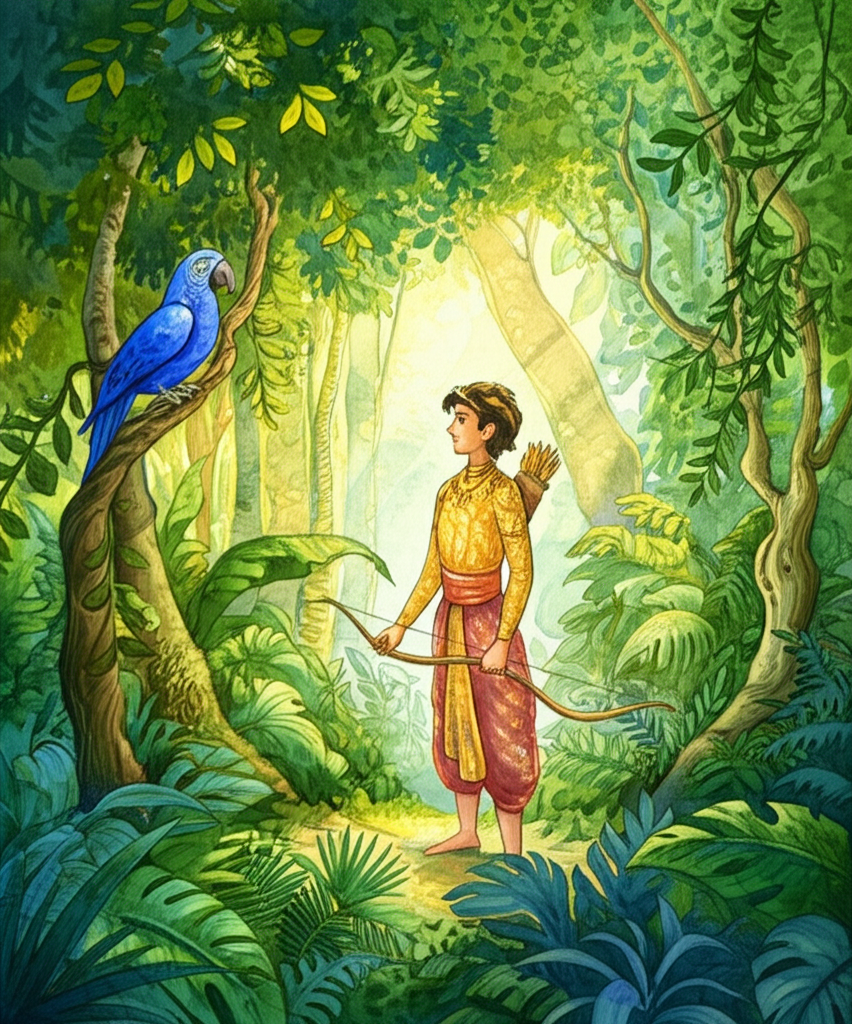
The young prince listened to his mother and obeyed her for a while. But one day, when he was hunting on the three sides where he was allowed, he remembered what she had said about the fourth side. He decided he had to go see why she didn’t want him to hunt there. When he got there, he found himself in a jungle filled with parrots! The parrots lived there. The young Raja shot at some of them, and all of them flew away into the sky, except for one. This one was their leader, and he was called Hiraman parrot.
When Hiraman parrot realized he was all alone, he called out to the other parrots, “Don’t fly away and leave me when the Raja’s son shoots! If you leave me like this, I’ll tell Princess Labam!”
Then the parrots all flew back to their leader, chattering loudly. The prince was very surprised and said, “Wow, these birds can talk!” Then he asked the parrots, “Who is Princess Labam? Where does she live?” But the parrots wouldn’t tell him where she lived. “You’ll never be able to get to Princess Labam’s country!” That’s all they would say.
The prince became very sad when they wouldn’t tell him anything more. He threw his gun away and went home. When he got home, he wouldn’t talk or eat. He just lay in his bed for days and seemed very sick.
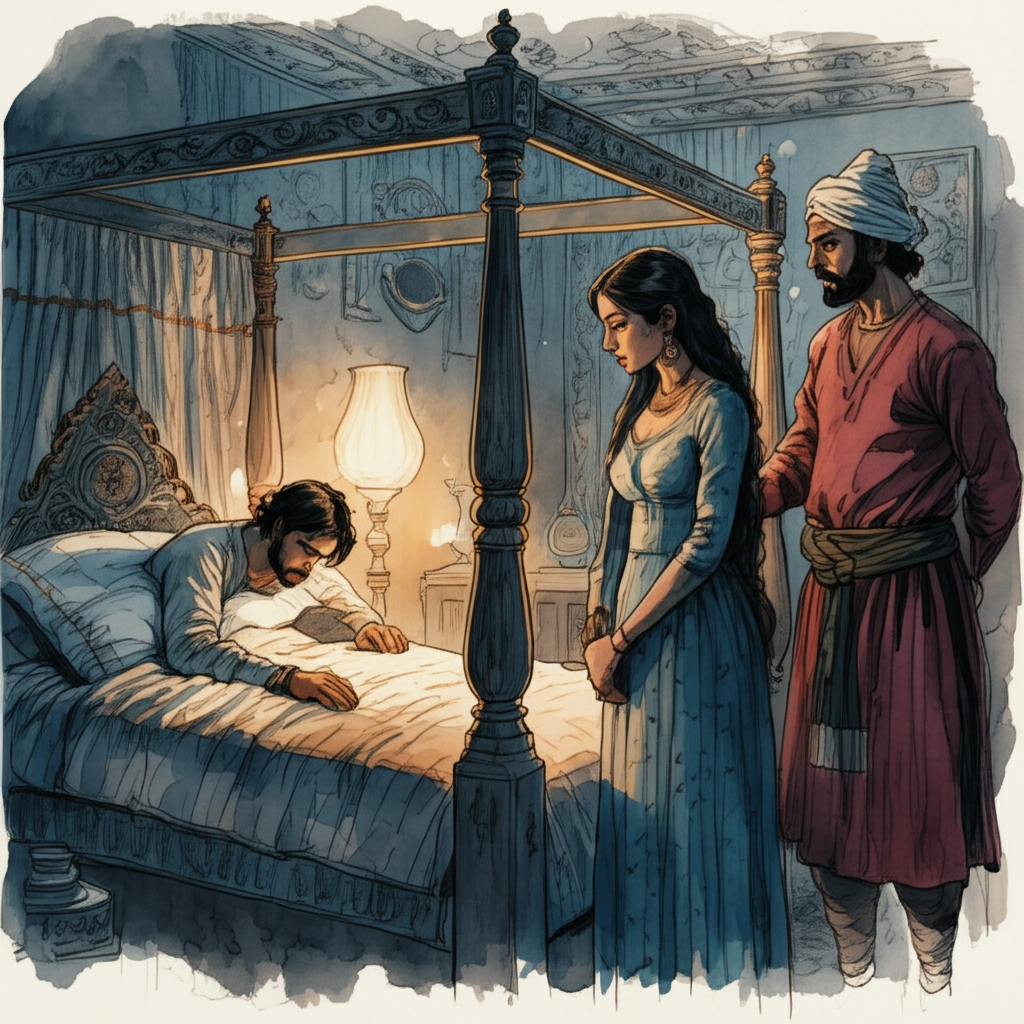
Finally, he told his parents that he wanted to go see Princess Labam. “I have to go,” he said. “I have to see what she looks like. Please tell me where her country is.” “We don’t know where it is,” his parents answered. “Then I have to go look for it,” said the prince. “No, no,” they said. “You can’t leave us! You’re our only son. Stay with us! You’ll never find Princess Labam.” “I have to try and find her,” said the prince. “Maybe God will show me the way. If I live and I find her, I’ll come back to you. But maybe I’ll die, and then I’ll never see you again. Still, I have to go.”
So they had to let him go, even though they cried a lot when they said goodbye. His father gave him nice clothes to wear and a beautiful horse. The prince took his gun, his bow and arrows, and lots of other weapons, because he thought he might need them. His father also gave him plenty of money.
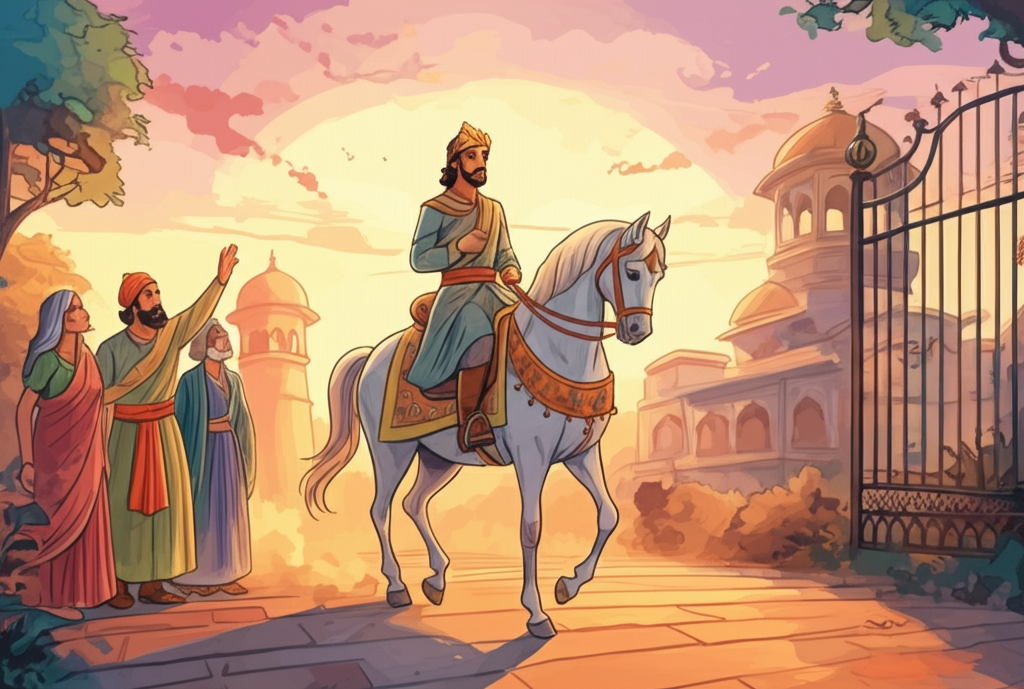
Then the prince got his horse ready for the journey. He said goodbye to his parents, and his mother took her handkerchief and wrapped some yummy sweets in it. She gave it to her son and said, “My child, when you’re hungry, eat some of these sweets.”
Then he started his journey. He rode on and on until he came to a jungle with a pond and shady trees. He and his horse took a bath in the pond, and then he sat down under a tree. “Now,” he said to himself, “I’ll eat some of the sweets my mother gave me, and I’ll drink some water, and then I’ll keep going.” He opened his handkerchief and took out a sweet. He found an ant in it! He took out another. There was an ant in that one too! So he put the two sweets on the ground. He took out another, and another, and another, until he had taken them all out, but each one had an ant in it! “That’s okay,” he said. “I won’t eat the sweets. The ants can eat them!” Then the Ant-King came and stood in front of him and said, “You’ve been good to us. If you ever need help, think of me, and we’ll come help you!”
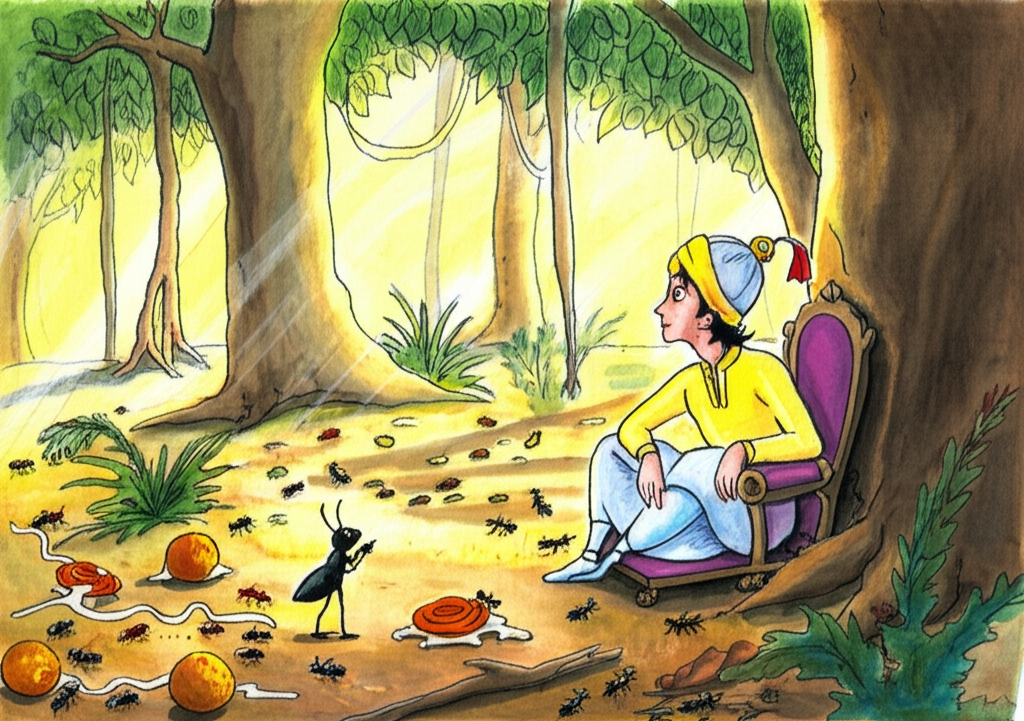
The Raja’s son thanked him, got on his horse, and kept going. He rode on and on until he came to another jungle. There he saw a tiger who had a thorn in his foot and was roaring loudly because of the pain.
“Why are you roaring like that?” said the young Raja. “What’s wrong?” “I’ve had a thorn in my foot for many years,” answered the tiger, “and it hurts so much! That’s why I’m roaring.” “Well,” said the Raja’s son, “I’ll take it out for you. But maybe, because you’re a tiger, you’ll eat me after I make you feel better?” “Oh, no,” said the tiger. “I won’t eat you! Please make me feel better!”
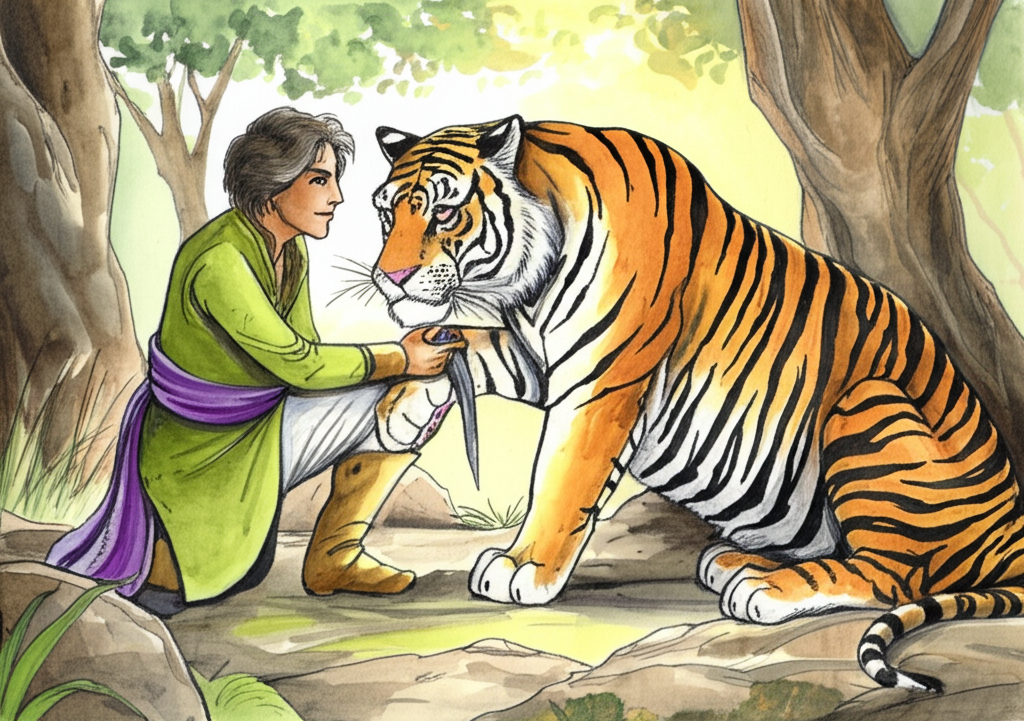
Then the prince took a small knife from his pocket and cut the thorn out of the tiger’s foot. But when he cut, the tiger roared louder than ever! His wife heard him in the next jungle and came running to see what was wrong. The tiger saw her coming and hid the prince in the jungle so she wouldn’t see him.
“What man hurt you that made you roar so loud?” said the wife. “No one hurt me,” answered her husband. “But a Raja’s son came and took the thorn out of my foot.” “Where is he? Show him to me!” said his wife. “If you promise not to kill him, I’ll call him,” said the tiger. “I won’t kill him. I just want to see him,” answered his wife.
Then the tiger called the Raja’s son, and when he came, the tiger and his wife bowed to him many times. Then they gave him a yummy dinner, and he stayed with them for three days. Every day he looked at the tiger’s foot, and on the third day, it was all better. Then he said goodbye to the tigers, and the tiger said to him, “If you ever need help, think of me, and we’ll come help you!”
The Raja’s son rode on and on until he came to a third jungle. Here he found four wise men arguing over four special things that their teacher had left behind when he died: a bed that could carry anyone who sat on it wherever they wanted to go; a bag that gave its owner whatever they wanted, like jewels, food, or clothes; a stone bowl that gave its owner as much water as they wanted, no matter how far they were from a pond; and a stick and rope that, if anyone tried to fight its owner, they could say, “Stick, beat all the people who are here!” and the stick would beat them, and the rope would tie them up.
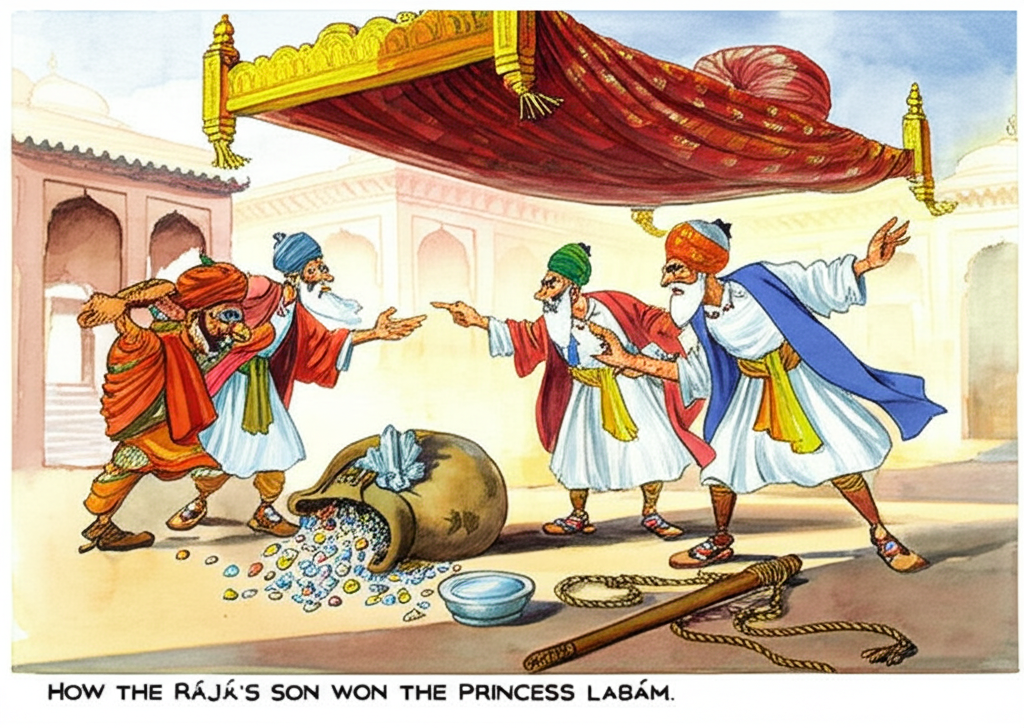
The four wise men were arguing over these four things. One said, “I want this!” another said, “You can’t have it, because I want it!” and so on.
The Raja’s son said to them, “Don’t argue over these things. I’ll shoot four arrows in four different directions. Whoever gets to my first arrow gets the first thing, the bed. Whoever gets to the second arrow gets the second thing, the bag. Whoever gets to the third arrow gets the third thing, the bowl. And whoever gets to the fourth arrow gets the last things, the stick and rope.” They agreed to this, and the prince shot off his first arrow. The wise men raced to get it. When they brought it back to him, he shot off the second, and when they had found and brought it to him, he shot off his third, and when they had brought him the third, he shot off his fourth.
While they were away looking for the fourth arrow, the Raja’s son let his horse loose in the jungle. He sat on the bed, taking the bowl, the stick and rope, and the bag with him. Then he said, “Bed, I want to go to Princess Labam’s country!” The little bed instantly rose up into the air and began to fly! It flew and flew until it came to Princess Labam’s country, where it landed on the ground. The Raja’s son asked some people he saw, “Whose country is this?” “Princess Labam’s country!” they answered. Then the prince went on until he came to a house where he saw an old woman. “Who are you?” she said. “Where do you come from?” “I come from a far country,” he said. “Please let me stay with you tonight.” “No,” she answered. “I can’t let you stay with me, because our king has said that people from other countries can’t stay in his country. You can’t stay in my house.” “You’re like my aunt,” said the prince. “Let me stay with you just for tonight. It’s evening, and if I go into the jungle, the wild animals will eat me!” “Well,” said the old woman, “you can stay here tonight, but you have to go away tomorrow morning. If the king hears you spent the night in my house, he’ll put me in prison!”
Then she took him into her house, and the Raja’s son was very happy. The old woman started preparing dinner, but he stopped her. “Aunt,” he said, “I’ll give you food.” He put his hand into his bag, saying, “Bag, I want some dinner!” and the bag instantly gave him a delicious dinner, served on two gold plates. The old woman and the Raja’s son ate together.
When they had finished eating, the old woman said, “Now I’ll get some water.” “Don’t go,” said the prince. “You’ll have plenty of water right away!” So he took his bowl and said to it, “Bowl, I want some water!” and it filled with water. When it was full, the prince cried out, “Stop, bowl!” and the bowl stopped filling. “See, aunt,” he said, “with this bowl, I can always get as much water as I want!”
By this time, night had come. “Aunt,” said the Raja’s son, “why don’t you light a lamp?” “There’s no need,” she said. “Our king has told the people in his country not to light any lamps. As soon as it’s dark, his daughter, Princess Labam, comes and sits on her roof. She shines so brightly that she lights up the whole country and our houses, and we can see to do our work as if it were day!”
When it was completely dark, the princess got up. She put on her fancy clothes and jewels, fixed her hair, and put a headband of diamonds and pearls across her head. Then she shone like the moon, and her beauty made night seem like day! She came out of her room and sat on the roof of her palace. She never came out of her house during the day. She only came out at night. All the people in her father’s country then went about their work and finished it.
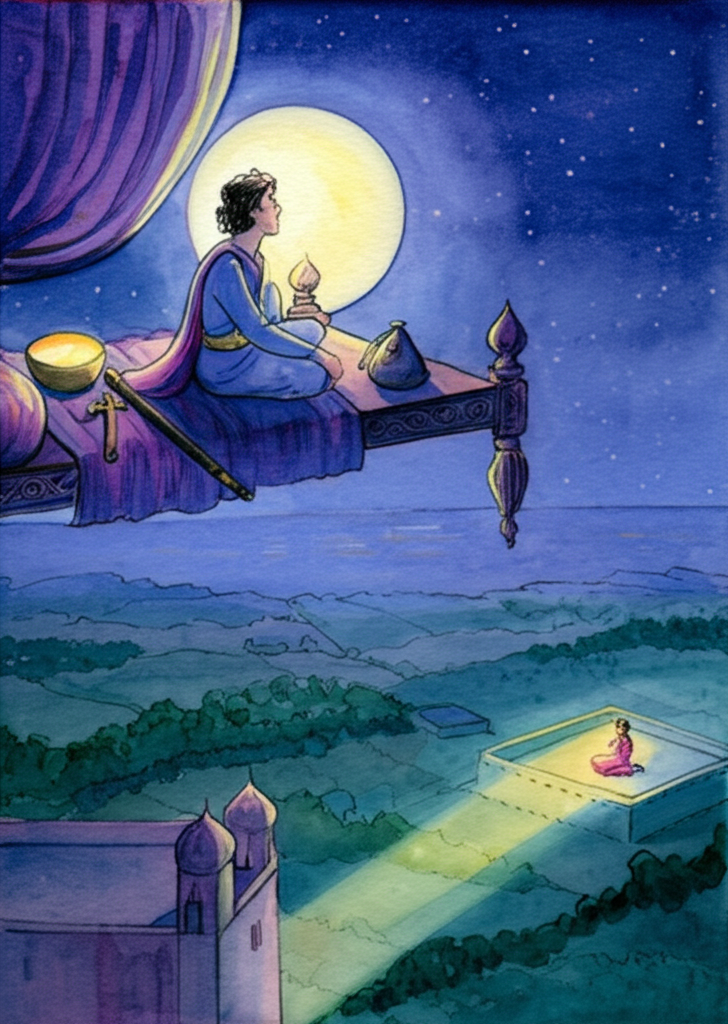
The Raja’s son watched the princess quietly and was very happy. He said to himself, “She’s so lovely!”
At midnight, when everyone had gone to bed, the princess came down from her roof and went to her room. When she was in bed and asleep, the Raja’s son got up quietly and sat on his bed. “Bed,” he said to it, “I want to go to Princess Labam’s bedroom!” So the little bed carried him to the room where she was fast asleep.
The young Raja took his bag and said, “I want a lot of betel leaves!” and it immediately gave him piles of betel leaves. He put them near the princess’s bed, and then his little bed carried him back to the old woman’s house.
The next morning, all the princess’s servants found the betel leaves and started eating them. “Where did you get all those betel leaves?” asked the princess. “We found them near your bed,” answered the servants. Nobody knew the prince had come in the night and put them there.
In the morning, the old woman came to the Raja’s son. “Now it’s morning,” she said, “and you have to go. If the king finds out what I’ve done for you, he’ll catch me!” “I feel sick today, dear aunt,” said the prince. “Please let me stay until tomorrow morning.” “Okay,” said the old woman. So he stayed, and they got their dinner out of the bag, and the bowl gave them water.
When night came, the princess got up and sat on her roof. At twelve o’clock, when everyone was in bed, she went to her bedroom and was soon fast asleep. Then the Raja’s son sat on his bed, and it carried him to the princess. He took his bag and said, “Bag, I want a very lovely shawl!” It gave him a beautiful shawl, and he spread it over the princess as she lay asleep. Then he went back to the old woman’s house and slept until morning.
In the morning, when the princess saw the shawl, she was delighted. “Look, Mother,” she said. “God must have given me this shawl! It’s so beautiful!” Her mother was very happy too. “Yes, my child,” she said. “God must have given you this splendid shawl!”
When it was morning, the old woman said to the Raja’s son, “Now you really have to go!” “Aunt,” he answered, “I’m not feeling well enough yet. Let me stay a few days longer. I’ll hide in your house so no one sees me.” So the old woman let him stay.
When it was dark night, the princess put on her lovely clothes and jewels and sat on her roof. At midnight, she went to her room and went to sleep. Then the Raja’s son sat on his bed and flew to her bedroom. There he said to his bag, “Bag, I want a very, very beautiful ring!” The bag gave him a gorgeous ring. Then he took Princess Labam’s hand gently to put on the ring, and she woke up, very frightened.
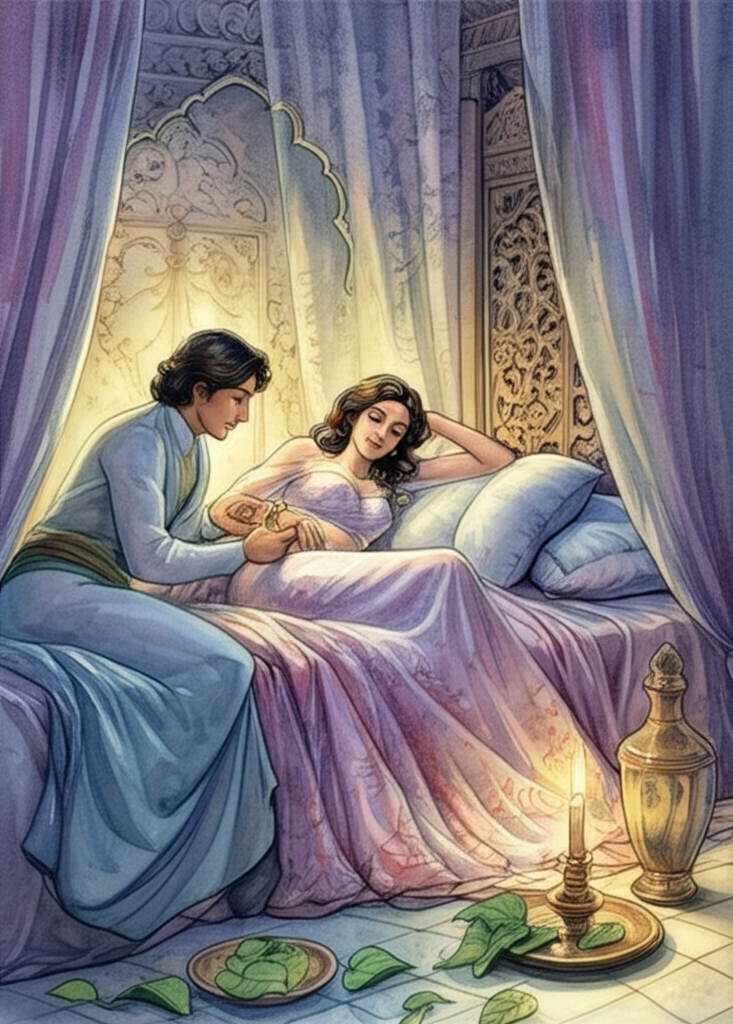
“Who are you?” she said to the prince. “Where do you come from? Why are you in my room?” “Don’t be afraid, princess,” he said. “I’m not a thief. I’m the son of a great Raja. Hiraman parrot, who lives in the jungle where I went hunting, told me your name. Then I left my parents and came to see you.”
“Well,” said the princess, “because you’re the son of such a great Raja, I won’t have you killed. I’ll tell my father and mother that I want to marry you.”
The prince then returned to the old woman’s house. When morning came, the princess said to her mother, “The son of a great Raja has come to this country, and I want to marry him!” Her mother told this to the king. “Good,” said the king. “But if this Raja’s son wants to marry my daughter, he must first do whatever I tell him. If he fails, I’ll kill him. I’ll give him a lot of mustard seeds, and he has to get all the oil out of them in one day. If he can’t do this, he’ll die!”
In the morning, the Raja’s son told the old woman that he wanted to marry the princess. “Oh,” said the old woman. “Leave this country and don’t think about marrying her! Lots of Rajas and Raja’s sons have come here to marry her, and her father has had them all killed. He says whoever wants to marry his daughter must first do whatever he tells them. If they can, then they can marry the princess. If they can’t, the king will have them killed. But no one can do the things the king tells them to do, so all the Rajas and Raja’s sons who have tried have been put to death. You’ll be killed too if you try. Please go away!” But the prince wouldn’t listen to anything she said.
The king sent his servants to the old woman’s house to get the prince. They brought the Raja’s son to the king’s court. There, the king gave him a big pile of mustard seeds and told him to get all the oil out of them that day and bring it to him the next morning. “Whoever wants to marry my daughter,” he said to the prince, “must first do all I tell them. If they can’t, then I have them killed. So if you can’t get all the oil out of these mustard seeds, you’ll die!”
The prince was very worried when he heard this. “How can I get all the oil out of all these mustard seeds in one day?” he said to himself. “If I don’t, the king will kill me!” He took the mustard seeds to the old woman’s house and didn’t know what to do. Finally, he remembered the Ant-King! The moment he did, the Ant-King and his ants came to him. “Why do you look so sad?” said the Ant-King. The prince showed him the mustard seeds and said to him, “How can I get all the oil out of all these mustard seeds in one day? If I don’t take the oil to the king tomorrow morning, he’ll kill me!” “Don’t worry,” said the Ant-King. “Lie down and sleep. We’ll get all the oil out for you during the day, and tomorrow morning you can take it to the king!” The Raja’s son lay down and slept, and the ants got the oil out for him. The prince was very happy when he saw the oil.
The next morning, he took it to the king in his court. But the king said, “You can’t marry my daughter yet. If you want to, you must first fight my two demons and kill them!” A long time ago, the king had caught two demons. He didn’t know what to do with them, so he locked them up in a cage. He was afraid to let them loose because they would eat all the people in his country, and he didn’t know how to kill them. So all the kings and kings’ sons who wanted to marry Princess Labam had to fight these demons, because the king thought, “Maybe the demons will get killed, and then I’ll be rid of them!”
When he heard about the demons, the Raja’s son was very sad. “What can I do?” he said to himself. “How can I fight these two demons?” Then he thought of his tiger! The tiger and his wife came to him and said, “Why are you so sad?” The Raja’s son answered, “The king has ordered me to fight his two demons and kill them. How can I do this?” “Don’t be scared,” said the tiger. “Don’t worry! My wife and I will fight them for you.”
Then the Raja’s son took two fancy coats out of his bag. They were all gold and silver and covered with pearls and diamonds. He put them on the tigers to make them look beautiful. He took them to the king and said to him, “Can these tigers fight your demons for me?” “Yes,” said the king, who didn’t care who killed his demons as long as they were killed. “Then call your demons,” said the Raja’s son, “and these tigers will fight them!” The king did so, and the tigers and the demons fought and fought until the tigers had killed the demons.
“That’s good,” said the king. “But you have to do something else before I give you my daughter. Up in the sky, I have a big drum. You have to go and beat it. If you can’t do this, I’ll kill you!”
The Raja’s son thought of his little bed, so he went to the old woman’s house and sat on it. “Little bed,” he said, “up in the sky is the king’s big drum. I want to go to it!” The bed flew up with him, and the Raja’s son beat the drum. The king heard him. But when he came down, the king still wouldn’t give him his daughter. “You’ve done the things I told you to do,” he said to the prince, “but you have to do one more thing!” “If I can, I will,” said the Raja’s son.
Then the king showed him a tree trunk that was lying near his court. It was a very, very thick trunk. He gave the prince a wax hatchet and said, “Tomorrow morning, you have to cut this trunk in two with this wax hatchet!”
The Raja’s son went back to the old woman’s house. He was very sad and thought that now the Raja would definitely kill him. “I had the ants get his oil out,” he said to himself. “I had the tigers kill his demons. My bed helped me beat his drum. But what can I do now? How can I cut that thick tree trunk in two with a wax hatchet?”
At night, he went on his bed to see the princess. “Tomorrow,” he said to her, “your father will kill me!” “Why?” asked the princess.
“He’s told me to cut a thick tree trunk in two with a wax hatchet! How can I ever do that?” said the Raja’s son. “Don’t be afraid,” said the princess. “Do what I tell you, and you’ll cut it in two very easily.”
Then she pulled a hair from her head and gave it to the prince. “Tomorrow,” she said, “when no one is near you, you have to say to the tree trunk, ‘Princess Labam commands you to let yourself be cut in two by this hair!’ Then put the hair down the edge of the wax hatchet’s blade.”
The prince did exactly as the princess had told him the next day. The minute the hair that was stretched down the edge of the hatchet blade touched the tree trunk, it split into two pieces!
The king said, “Now you can marry my daughter!” Then the wedding took place. All the Rajas and kings of the countries around were invited, and there were big celebrations! After a few days, the prince said to his wife, “Let’s go to my father’s country!” Princess Labam’s father gave them lots of camels, horses, money, and servants, and they traveled in style to the prince’s country, where they lived happily ever after!

The prince always kept his bag, bowl, bed, and stick. But because no one ever tried to fight him, he never needed to use the stick.
